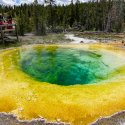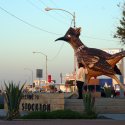As Above, So Below
By Ivy MorrisA walk connects Seattle’s below-ground history and its metropolitan future
There’s no denying that Seattle is a city of pioneers. From its beginnings as a force in the lumber industry to its continuing prosperity in software and technology, Seattle makes booming its business.
For evidence, look to the skyline. Iconic buildings serve as a bit of architectural history, symbolizing eras of prosperity. Today, Seattle has one of the most recognized city skylines in the United States. But for a complete picture, you’re also going to need to look beneath that storied cityscape.
The best way to immerse yourself in the city’s past, present, and future? On foot. Explore from below sea level to more than 600 feet above ground to see how Seattle is rising to meet whatever comes next.
Peek at the past
The heart of the city in Seattle’s early days, Pioneer Square began as a gathering ground for new settlers. While today it’s a neighborhood filled with trendy bars, restaurants, and shops, the past is not so easily forgotten.
When the Great Seattle Fire destroyed 31 blocks in 1889, city leaders took the opportunity to mandate that streets needed to be regraded one or two stories higher than they were before. Seattle’s first pioneers had built Pioneer Square on filled-in tidelands that often flooded—a stinky situation when sewage from Elliott Bay backed up into the city at high tide.
While the land around them rose, the original building foundations remained in use—accessible by ladders and stairways—for a little more than a decade after the regrade. City officials eventually shut down the Underground in 1907 for fear of bubonic plague (carried by rats that liked the below-ground shelter). But the city’s underground stories don’t end there.
Since 1965, Bill Speidel’s Underground Tour has revealed what lies below Pioneer Square—the vestiges of pre-1889 Seattle. A step into the past begins by crossing through a locked gate and descending into a series of nooks and crannies. If these walls could talk… Remnants of post-condemned illegal speakeasies and movie sets from filmings decades ago are spread throughout the quiet underground. Above, a bustling Seattle is none-the-wiser to these secrets hidden from view. Purple pavement lights connect the two worlds, allowing illumination to trickle in from the streets above.
Back on the surface, Yesler Way borders Pioneer Square, leading straight to the ferry terminal and Elliott Bay. When Seattle was building its foundations, however, you wouldn’t want to walk along this avenue. One of Seattle’s first booms was the lumber industry. During this period, Yesler Way was known for the large amount of timber that would skid down the hill to Henry Yesler’s sawmill. Locals nicknamed it “Skid Road,” and when the street later became derelict, the term spread beyond the city. From then on, city areas that were downtrodden became known as Skid Rows.
Connecting then to now
Smith Tower, high above Pioneer Square, connects the past to the future. Built in 1914, this building is now a combination of event and office space for modern marketing firms, graphic designers, and more. At 42 stories tall, this obelisk tower-topped building also features an observatory that’s open to the public with views of Elliott Bay, Mount Rainier, and the Olympic and Cascade mountain ranges. The observatory wraps around the tippy-top stem of the tower, just before its four sides angle into a peak.
Inside that peak is the most enviable real estate in the city—an apartment that looks out over Seattle. When last reported upon, the apartment was owned by a former venture capitalist and colleague of local artist Dale Chihuly. In the living room, a stunning Egyptian-blue glass Chihuly sculpture hangs as a chandelier and incredible focal point.
It’s impossible to discuss the city’s iconic architecture without mentioning the Space Needle. Part observation tower, all tourist attraction, the Space Needle is a landmark of the Pacific Northwest and an icon of Seattle. Built for the 1962 World’s Fair, at the time it was the tallest structure west of the Mississippi River (605 feet high and 138 feet wide).
Today, its historic past has been updated for years ahead. At 500 feet, the recently renovated SkyCity restaurant now rotates for non-neck-craning views and also includes futuristic, and heights-phobic prohibiting, see-through glass floors.
Looking ahead & a-round
The newest architectural wonders in Seattle, the Seattle Spheres, are three phenomenal greenhouses on the campus of Amazon headquarters. It only makes sense that the company contribute toward a “growing” future in its hometown. The domes are composed of pentagon-shaped arched windows and are filled with more than 40,000 plants from 50 countries. The most famous? Rubi, a 55-foot Ficus tree that was lifted into the spheres by crane. Rubi’s also the largest resident, comfortable under the up-to-four-story-tall domes.
Besides being a horticulturists’ dream, the spheres serve as meeting spaces for Amazon employees and also house retail stores. The spheres are open to the public through weekly tours (by reservation only) and an exhibit on the ground floor.
What’s next in Seattle? That’s up to you. While the city’s icons have stories to tell, and stories to innovate, it’s best to create your own.
Duck into dive bars and peek into restaurants that pique your interest. In a city of movers and shakers, each day brings an opportunity to become the next big thing.


